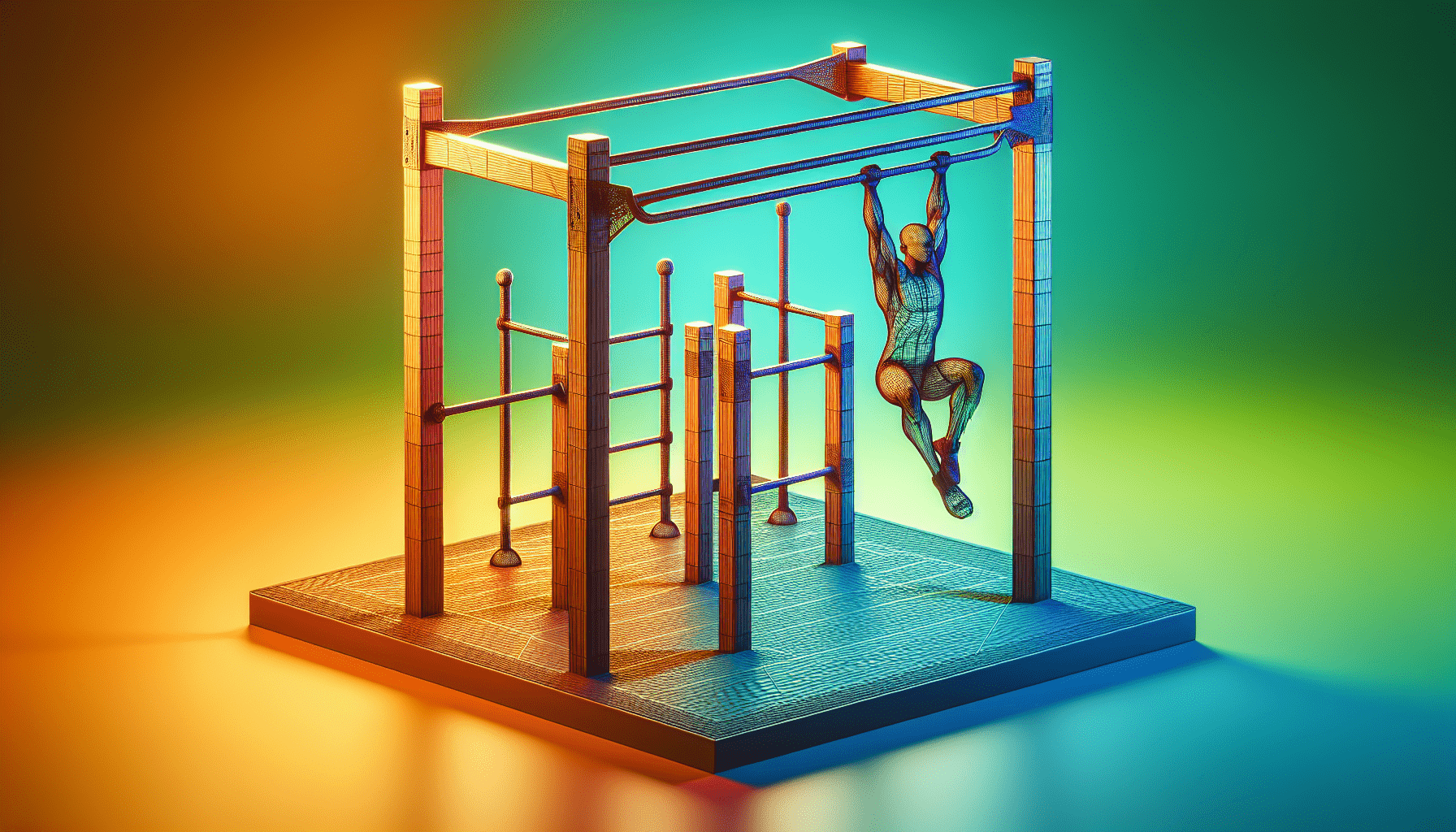Are you interested in improving your strength and flexibility through bodyweight exercises? Look no further than the Calisthenics Progressions Chart. This comprehensive guide offers a visual representation of the various movements and progressions you can undertake to achieve your fitness goals. Whether you’re a beginner or an advanced practitioner, this chart will provide you with the necessary roadmap to track your progress and challenge yourself further. Get ready to elevate your workout routine to new heights with the help of this invaluable tool.
What is Calisthenics?
Definition of Calisthenics
Calisthenics is a form of exercise that involves using your body weight to perform various movements and exercises. It is a popular fitness option that requires minimal equipment and can be done virtually anywhere. The word “calisthenics” originates from the Greek words “kallos,” meaning beauty, and “sthenos,” meaning strength. This fitness discipline focuses on developing strength, flexibility, agility, and overall fitness through bodyweight exercises.
Benefits of Calisthenics
Calisthenics offers a wide range of benefits for individuals of all fitness levels. Here are some key advantages of incorporating calisthenics into your exercise routine:
-
Strength and Muscle Development: Calisthenics exercises work multiple muscle groups simultaneously, promoting overall strength and muscle development.
-
Increased Flexibility: Many calisthenics movements require a full range of motion, helping to improve flexibility and joint mobility.
-
Improved Body Control: Calisthenics exercises often involve complex movements that challenge coordination and body control, leading to better movement patterns and posture.
-
Convenience and Accessibility: Calisthenics can be done anywhere, anytime, without the need for specialized equipment or a gym membership. This makes it a highly accessible form of exercise.
-
Functional Fitness: Calisthenics movements mimic everyday actions, enhancing your ability to perform daily tasks and activities with ease.
-
Improved Cardiovascular Endurance: Many calisthenics exercises, such as burpees and mountain climbers, require dynamic movements that elevate the heart rate, improving cardiovascular fitness.
-
Mental Well-being: Engaging in regular calisthenics workouts can boost mood, reduce stress levels, and promote mental clarity and focus.
-
Versatility and Progression: Calisthenics offers a wide variety of exercises and progressions, allowing individuals to continuously challenge themselves and progress in their fitness journey.
How Calisthenics Progressions Work
Calisthenics progressions involve gradually increasing the difficulty of exercises as your strength and skill levels improve. This allows for progression and continuous improvement over time. By breaking down complex movements into smaller, more achievable steps, calisthenics progressions help individuals build a solid foundation before moving on to more advanced exercises. Progressions can be achieved by adjusting the intensity, range of motion, or adding variations to an exercise. A well-designed calisthenics progressions chart can serve as a guide to help individuals track their progress and ensure systematic improvement.
Understanding Calisthenics Progressions
What are Calisthenics Progressions?
Calisthenics progressions are a series of exercises or variations that enable individuals to gradually develop the strength, skill, and mobility required to perform advanced movements. Progressions are structured in a way that ensures individuals can safely and effectively work towards their fitness goals. They provide a roadmap for individuals to progress from more basic exercises to more complex ones.
Why are Progressions Important?
Progressions are important as they prevent individuals from attempting exercises that may be too difficult for their current fitness level. By starting with easier variations and gradually advancing to more challenging ones, progressions help individuals develop the necessary strength, stability, and mobility to perform advanced movements safely. Additionally, progressions provide a sense of accomplishment and motivation as individuals witness their gradual improvement over time.
How to Use a Calisthenics Progressions Chart
A calisthenics progressions chart is a visual representation of the various exercises and progressions within a calisthenics routine. It serves as a guide to help individuals track their progress and ensure they are following a systematic approach to their training. To use a calisthenics progressions chart effectively, follow these steps:
-
Identify Your Current Fitness Level: Determine which level of progressions (beginner, intermediate, or advanced) is most suitable for your current fitness level and experience.
-
Start with Basics: Begin with the first exercise or progression in the chart that corresponds to your current level. Focus on mastering each exercise with proper form and technique before progressing to the next level.
-
Track Your Progress: Use the chart to mark your progress as you successfully complete each exercise or progression. This helps you stay motivated and provides a clear visual record of your achievements.
-
Gradually Increase Difficulty: As you become more comfortable and proficient with an exercise, move on to the next progression or variation in the chart. This ensures a gradual increase in difficulty and helps you continue challenging your muscles and improving your fitness.
-
Adjust Based on Individual Abilities: It is essential to listen to your body and make adjustments as needed. If an exercise feels too challenging or causes discomfort, regress to a previous progression until you have built sufficient strength and skill.
Exploring Different Calisthenics Progressions
Push-up Progressions
Push-up progressions allow individuals to gradually build upper body strength and improve their pushing movements. Starting with modified push-ups (such as inclined or knee push-ups), individuals can progress to standard push-ups, diamond push-ups, one-arm push-ups, and even more advanced variations.
Pull-up Progressions
Pull-up progressions focus on developing upper body pulling strength, specifically targeting the back, shoulders, and arms. Beginners can start with assisted pull-ups using resistance bands or a partner’s assistance. As strength improves, individuals can progress to standard pull-ups, commando pull-ups, muscle-ups, and other challenging variations.
Squat Progressions
Squat progressions help individuals improve lower body strength and mobility. Starting with basic bodyweight squats, individuals can progress to pistol squats (single-leg squats), jump squats, Bulgarian split squats, and eventually more advanced variations such as weighted squats or pistol squats on unstable surfaces.
Lunge Progressions
Lunge progressions focus on enhancing lower body strength, stability, and balance. Starting with forward lunges or stationary lunges, individuals can progress to reverse lunges, walking lunges, jump lunges, and more dynamic variations like lunge jumps or Bulgarian split jumps.
Plank Progressions
Plank progressions target core strength and stability. Starting with a basic forearm plank, individuals can progress to high plank, side plank, reverse plank, and more challenging variations such as plank rotations, plank walks, or plank with leg lifts.
Calisthenics Progressions Chart Features
Organized Structure
A well-designed calisthenics progressions chart follows a logical and progressive structure, starting from the foundational exercises and gradually increasing in difficulty. This allows individuals to systematically work their way up to more advanced movements.
Visual Representations
Calisthenics progressions charts often utilize visual representations or illustrations to demonstrate each exercise or progression. This makes it easier for individuals to understand and replicate the movements correctly.
Individual Progress Tracking
One of the key features of a calisthenics progressions chart is the ability to track individual progress. Whether through checkboxes, symbols, or colors, individuals can mark their completion of each exercise or progression, ensuring they can visually see their improvement over time.
Exercise Difficulty Levels
A calisthenics progressions chart typically includes different difficulty levels or categories, such as beginner, intermediate, and advanced. This allows individuals to select the appropriate exercises and progressions based on their current fitness level and abilities.
How to Create Your Own Calisthenics Progressions Chart
Identify Your Fitness Goals
Before creating a calisthenics progressions chart, it is essential to identify your specific fitness goals. Determine what areas of strength, flexibility, or skill you want to focus on and tailor your progressions accordingly.
Select Appropriate Exercises
Choose exercises that align with your fitness goals and target the muscle groups you want to develop. Begin with foundational movements and gradually progress to more advanced variations. Consider exercises such as push-ups, pull-ups, squats, lunges, and planks as starting points.
Arrange Exercises in Logical Order
Organize the exercises in a logical sequence that allows for progressive difficulty. Start with easier variations and gradually increase the challenge as individuals build strength, skill, and mobility.
Determine Progression Steps
Break down each exercise into smaller progressions or variations. Identify the key milestones or progressions that individuals need to achieve before moving on to the next level.
Graphical Representation
Create visual representations or illustrations of each exercise and progression. This can be done through drawings, diagrams, or even photographs. Visual aids make it easier for individuals to understand and follow the chart.
Important Considerations when Using a Calisthenics Progressions Chart
Proper Form and Technique
Maintaining proper form and technique throughout each exercise is crucial to prevent injury and maximize the effectiveness of the movement. Pay close attention to instructions and seek guidance from fitness professionals if needed.
Warm-up and Cool-down
Prioritize warm-up exercises specific to the muscles being targeted. This helps prepare the body for the workout and reduces the risk of injury. Similarly, cool-down exercises such as stretching or light cardio can help prevent muscle soreness and aid in recovery.
Rest and Recovery
Allow your body time to rest and recover between workouts. Overtraining can lead to fatigue, decreased performance, and an increased risk of injury. Incorporate rest days and listen to your body’s signals.
Listening to Your Body
Every individual is unique, and it is important to listen to your body’s cues. If an exercise feels too challenging or causes discomfort, regress or modify the progression until you are more prepared.
Seeking Professional Guidance
If you are new to calisthenics or unsure about proper technique or progressions, consider seeking guidance from a certified fitness professional. They can provide personalized advice and ensure you are on the right track.
Benefits of Using a Calisthenics Progressions Chart
Structured Approach to Fitness
A calisthenics progressions chart provides a structured approach to fitness, ensuring individuals follow a systematic progression and avoid haphazard training. This helps individuals stay focused and motivated towards their fitness goals.
Trackable and Measurable Progress
By marking off completed exercises or progressions on the chart, individuals can see their progress in a tangible way. This sense of accomplishment and measurable progress can boost motivation and drive continued improvement.
Avoid Plateaus and Boredom
Calisthenics progressions allow individuals to continuously challenge themselves and avoid plateaus. As each exercise becomes easier, progressing to the next level ensures ongoing growth and prevents stagnation or boredom.
Suitable for Different Fitness Levels
Calisthenics progressions can be tailored to suit individuals of various fitness levels. Whether you are a beginner or an advanced athlete, there are progressions that can challenge and benefit you.
Cost-effective and Flexible
Calisthenics requires minimal equipment, making it a cost-effective exercise option. Additionally, it can be done anywhere, providing flexibility and convenience for individuals with busy schedules or limited access to fitness facilities.
Common Mistakes to Avoid with Calisthenics Progressions
Skipping Progression Steps
One common mistake is attempting exercises that are too challenging without adequately mastering the previous progressions. This can lead to poor form, increased risk of injury, and slower progress in the long run.
Ignoring Proper Form
Maintaining proper form and technique is essential in calisthenics. Neglecting form can compromise the effectiveness of the exercise and increase the risk of injury. Focus on quality over quantity.
Overtraining and Injury Risk
Pushing too hard without allowing sufficient rest and recovery can lead to overtraining, fatigue, and an increased risk of injury. Listen to your body and give yourself enough time to rest and rebuild.
Not Adapting to Individual Abilities
Each individual has different strengths, weaknesses, and abilities. It is important to adapt calisthenics progressions to suit your current fitness level and skill set. Don’t compare yourself to others and progress at your own pace.
Examples of Calisthenics Progressions Charts
Beginner Level Progressions
- Push-ups: Incline push-ups, knee push-ups, full push-ups
- Pull-ups: Assisted pull-ups, negative pull-ups, scapular pull-ups, full pull-ups
- Squats: Bodyweight squats, assisted squats, pistol squats
- Lunges: Stationary lunges, reverse lunges, walking lunges, jump lunges
- Planks: Forearm plank, high plank, side plank
Intermediate Level Progressions
- Push-ups: Wide push-ups, diamond push-ups, decline push-ups
- Pull-ups: Close-grip pull-ups, one-arm assisted pull-ups, commando pull-ups
- Squats: Jump squats, Bulgarian split squats, goblet squats
- Lunges: Jump lunges, lunge walks with weights, Bulgarian split jumps
- Planks: Plank with leg lifts, plank rotations, plank walks
Advanced Level Progressions
- Push-ups: One-arm push-ups, handstand push-ups, planche push-ups
- Pull-ups: Muscle-ups, front lever pull-ups, one-arm pull-ups
- Squats: Weighted squats, pistol squats on unstable surfaces
- Lunges: Split squat jumps, plyometric lunges, Bulgarian split squat with weights
- Planks: Plank with knee tucks, side plank with rotations, plank with arm balance
Conclusion
Calisthenics progressions are a valuable tool for individuals looking to improve their strength, flexibility, and overall fitness. By gradually increasing the difficulty of exercises, progressions allow individuals to safely and systematically improve their skills and achieve their fitness goals. By utilizing calisthenics progressions charts, individuals can track their progress, avoid plateaus, and maintain motivation throughout their fitness journey. Remember to prioritize proper form, listen to your body, and seek professional guidance whenever necessary. With a structured and progressive approach, you can achieve your desired level of fitness and enjoy the numerous benefits that calisthenics offers.



